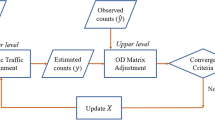Abstract
The Automatic Vehicle Identification (AVI) system was recently installed in expressway networks in Japan. License plate numbers of passing vehicles are monitored through roadside AVI cameras and then recognized. This paper shows the formulation of origin and destination (OD) matrices estimation model using the observed data with the AVI system. The results of license plate matching between a pair of AVI cameras are involved as the input variables. The formulated model is a least squares model and yields to the linear transformation of the partly observed OD matrices. The model is applied to the Kobe corridor line in the Han-Shin expressway network. It is found that the estimated OD matrix is consistent with the one using the previous mail survey. The proposed estimation method is expected to investigate the day-to-day fluctuations of OD patterns in the expressway network.
Similar content being viewed by others
References
Asakura Y, Ohkubo T & Tanabe J (1997) Time Dependent OD Matrix Estimation Method Using Monitoring Data in the Hanshin Expressway Network. CD-ROM of the 4th ITS Conference in Berlin.
Bell MGH (1991) The real time estimation of origin-destination flows in the presence of platoon dispersion. Transportation Research-B 25: 115-125.
Camus R Longo G Santorini F (1995) A short term forecasting model of freeway traffic monitoring and control. In: Stephanedes and Filippi (eds) Applications of Advanced Technologies in Transportation Engineering. New York, ASCE, pp. 418-422.
Cascetta E, Inaudi D & Marquis G (1993) Dynamic estimators of origin-destination matrices using traffic data. Transportation Science 27: 363-373.
Chang GL & Wu J (1994) Recursive estimation of time-varying origin-destination flows from traffic counts in freeway corridors. Transportation Research-B28: 141-160.
Madanat S, Krogmeier J & Hu SR (1995) An enhanced Kalman Filtering Algorithm for dynamic freeway OD matrix estimation & prediction. In: Stephanedes and Filippi (eds) Applications of Advanced Technologies in Transportation Engineering. New York, ASCE, pp. 423-428.
Makigami Y, Murakami Y, Takeuchi H & Shimizu K (1995) Basic study on travel time measurement using automatic vehicle identification systems in connection with congestion. Proc of the 2nd ITS Congress in Yokohama, Vol 1, pp. 181-190.
Sachse T & Schmid H (1995) VARIA-variable message sign control based on OD-estimation in a motorway network. In: Stephanedes & Filippi (eds) Applications of Advanced Technologies in Transportation Engineering. New York, ASCE, pp. 383-387.
Seki S (1995) Travel time measurement & provision system using AVI units. Proc of the 2nd ITS Congress in Yokohama, Vol 1, pp. 50-55.
Sugiyama M, Tanabe J, Asakura Y & Daito T (1996) Time Dependent OD Matrix Estimation from Traffic Counts and AVI Data on the Hanshin Expressway. CD-ROM of the 3rd ITS Conference in Orlando (#AP3192).
Watling DP (1994) Maximum likelyhood estimation of an origin-destination matrix from a partial registration plate survey. Transportation Research-B 28: 289-314.
Yang H, Akiyama T & Sasaki T (1998) Estimation of time-varying origin-destination flows from traffic counts: a neural network approach. Mathl Comput Modelling 27: 323-334.
Yasui K, Ikenoue K & Takeuchi H (1995) Use of AVI information linked up with detector in travel time Prediction & OD flow estimation. Proc of the 2nd ITS Congress in Yokohama, Vol 1, pp. 94-99.
Author information
Authors and Affiliations
Corresponding author
Rights and permissions
About this article
Cite this article
Asakura, Y., Hato, E. & Kashiwadani, M. Origin-destination matrices estimation model using automatic vehicle identification data and its application to the Han-Shin expressway network. Transportation 27, 419–438 (2000). https://doi.org/10.1023/A:1005239823771
Issue Date:
DOI: https://doi.org/10.1023/A:1005239823771




